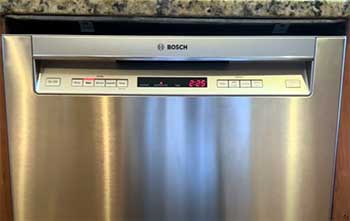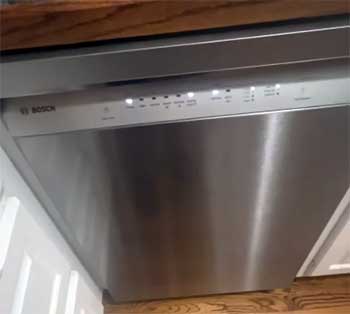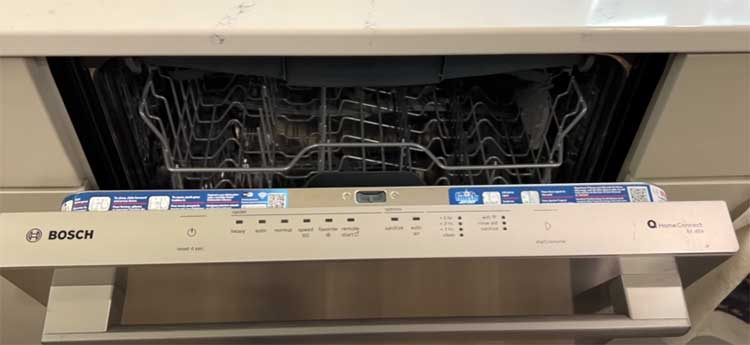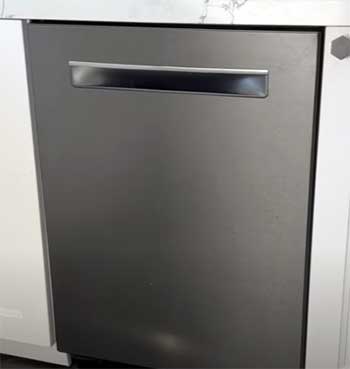As I stood in the appliance store, staring at a wall of stainless steel, the choice felt overwhelming. I knew I wanted a Bosch dishwasher—my research had told me they were quiet, reliable, and top-performers.
The real question was, which one? The price jump between the 300, 500, and 800 series was significant. Through extensive research and hands-on experience, I’ve navigated this exact decision.
My goal here is to share what I’ve learned, breaking down the essential differences so you can confidently choose the perfect Bosch dishwasher for your home, your needs, and your budget.
Bosch Dishwasher Series At A Glance
| Feature | Bosch 300 Series | Bosch 500 Series | Bosch 800 Series |
| Noise Level (dBA) | ~44-46 dBA | ~44 dBA | ~39-42 dBA |
| Primary Drying Tech | PureDry (Condensation) | AutoAir (Door Pops Open) | CrystalDry (Zeolite Minerals) |
| Third Rack | Standard 3rd Rack | Flexible 3rd Rack | MyWay Rack or Flexible 3rd Rack |
| Racking System | RackMatic (Adjustable) | RackMatic, EasyGlide Wheels | RackMatic, EasyGlide, FlexSpace Tines |
| Control Style | Front or Top Controls | Top Controls Only | Top Controls Only |
| Interior Tub | Stainless Steel | Stainless Steel | Stainless Steel |
| Leak Protection | 24/7 AquaStop | 24/7 AquaStop | 24/7 AquaStop Plus |
| Standout Feature | Excellent Value & Quietness | AutoAir for Better Drying | CrystalDry & Near-Silent Operation |
| Best For | Value-conscious buyers | Users wanting better drying | Performance-driven users |
The Bosch Baseline: What You Get With Every Series?
Before we start comparing, it’s crucial to understand what makes a Bosch a Bosch. Regardless of whether you spend the money on a 300 or an 800 Series, you’re getting a foundation of exceptional German engineering.
I found this reassuring during my own selection process; it wasn’t about buying a “good” vs. “bad” machine, but about choosing the right feature set.
Every dishwasher from these three series comes with a stainless steel tub. This is a non-negotiable feature for me.
Unlike plastic tubs that can absorb odors and stains over time, stainless steel is more durable, hygienic, and aids in drying by retaining heat from the final rinse cycle. This heat helps water condensate and run off the dishes, which is the basis of Bosch’s standard drying system.
Another universal feature is the 24/7 AquaStop leak protection system. It’s a brilliant piece of engineering that provides genuine peace of mind. The system has sensors that can detect a leak in the solid molded base of the dishwasher.
If it senses water where it shouldn’t be, it immediately shuts down operation and pumps out the water before it can ever touch your kitchen floor. I’ve heard horror stories from friends about other brands flooding their kitchens, so having this feature as a standard is a massive plus.
Finally, they are all designed to be quiet. Even the “loudest” of the bunch, the 300 Series, is significantly quieter than many competitors’ flagship models.
Bosch uses multiple layers of insulation, a solid base to absorb sound, and a brushless EcoSilence motor system to ensure you can run the dishwasher without disrupting a conversation or your favorite TV show.
The Workhorse: A Deep Look At The Bosch 300 Series

I often describe the 300 Series as the gateway to premium dishwashing.
It’s the point where you leave behind the compromises of budget brands and step into a world of quiet, effective cleaning.
This is the model I recommend to most of my friends and family who just want a fantastic dishwasher that works reliably without needing a ton of bells and whistles.
The headline feature for the price is its quietness. Clocking in around 44-46 decibels (dBA), it’s about the sound level of a quiet library. When I first ran a 300 Series at a friend’s house, I had to put my ear to the door to confirm it was even on.
Many models in this series come with an InfoLight, which projects a small red dot onto the floor to let you know a cycle is in progress. It’s a simple, elegant solution to the “is it running?” problem created by its own silent operation.
Inside, the 300 Series introduced me to the magic of the third rack. This isn’t just a flat tray for a few knives. It’s a dedicated space for silverware, cutlery, and small utensils like ramekins or espresso cups.
Moving silverware out of a basket in the lower rack frees up an immense amount of space for pots, pans, and plates. It’s a feature that, once you have it, you can never go back.
The racking system itself is called RackMatic. This allows you to adjust the height of the middle rack to three different levels, even when it’s fully loaded. I found this incredibly useful after a big dinner party when I had tall wine glasses on the top and a large stockpot on the bottom.
The primary weakness, if you can call it that, lies in its drying system. The 300 Series uses PureDry, which is Bosch’s brand name for a closed-system condensation drying method.
It relies on the hot water from the final rinse heating up the stainless steel tub. The tub then draws moisture from the dishes, where it condenses and is drained away. It works very well for glassware and ceramic plates, but it struggles with plastics.
You will almost always have to towel-dry plastic food containers or kids’ cups.
Pros of the 300 Series

- Incredible Value: You get the core benefits of Bosch engineering—quietness, reliability, and cleaning power—at the most accessible price point. It represents a massive leap in quality over most other brands in its price range.
- Surprisingly Quiet: At 44-46 dBA, it’s quieter than many competitors’ more expensive models. The InfoLight is a thoughtful touch to compensate for the silent performance.
- Functional Third Rack: The standard third rack is a game-changer for interior capacity and organization, making loading and unloading silverware much more efficient.
Cons of the 300 Series
- Basic Drying Performance: The PureDry system is effective on most materials but leaves plastics and items with concave bottoms (like the top of a coffee mug) damp. This is the most common complaint and the biggest reason to upgrade.
- Less Flexible Racking: While the RackMatic system is great, the tines are less adjustable than in higher series, and it lacks the super-smooth EasyGlide wheels. Loading can sometimes feel a bit less fluid.
- Control Options: You can find models with front controls, which some people find dated, or top controls for a cleaner look. The higher series are exclusively top-control.
The Sweet Spot: Why The Bosch 500 Series Shines

For many people, myself included, the 500 Series represents the perfect intersection of features and cost. It takes everything great about the 300 Series and adds one pivotal feature that addresses its biggest shortcoming: AutoAir.
AutoAir is brilliantly simple. At the end of the drying cycle, the dishwasher automatically pops the door open about four inches. This allows moisture and steam to escape and fresh, dry air to circulate inside.
The result?
Dramatically improved drying performance across the board, especially on those pesky plastics. When I first used a machine with this feature, the difference was immediately noticeable.
Plastic containers that would have been dripping wet in a 300 Series machine were now mostly dry and ready to be put away. It’s not a gimmick; it’s a practical solution that makes a real difference in daily use.
The 500 Series also offers a tangible upgrade in the interior. The racks feature EasyGlide wheels, making the upper rack slide in and out with a silky smoothness that just feels more premium.
The third rack is also upgraded to the “Flexible 3rd Rack.” It has a V-shape with adjustable sides that you can lower to accommodate deeper items like ladles, whisks, or cereal bowls, adding another layer of loading versatility.
Noise levels are generally on par with the 300 series, hovering around 44 dBA, which is already exceptionally quiet.
Aesthetically, the 500 Series moves to a sleeker, more modern look, offered exclusively with hidden top controls and a choice of a pocket handle or a professional-style bar handle. It looks more integrated and high-end in a modern kitchen.
To me, the 500 Series feels like the model Bosch designed for the discerning homeowner who is willing to pay a little more for a feature that solves a major annoyance. The frustration of having to towel-dry half the dishes is a real one, and AutoAir is a direct, effective answer.
Pros of The 500 Series
- AutoAir for Superior Drying: This is the killer feature. By automatically opening the door, it significantly improves drying results, especially on plastics, without a massive energy cost.
- Upgraded Interior: The Flexible 3rd Rack adds more utility than the standard version, and the EasyGlide wheels on the middle rack provide a smoother, more premium user experience.
- Balanced Price and Performance: It offers a substantial, tangible upgrade over the 300 Series for a moderate price increase, making it arguably the best overall value in the entire lineup.
Cons of The 500 Series
- Still Not Perfect Drying: While a huge improvement, AutoAir isn’t magic. Deeply concave surfaces can still pool a little water, and it’s not quite as effective as the system in the 800 Series.
- No Significant Noise Reduction: It’s just as quiet as the 300 Series, not quieter. If absolute silence is your primary goal, you’ll need to keep climbing the ladder.
- Exclusively Top Control: This is a pro for many, but if you’re someone who genuinely prefers to see the cycle progress on the front of the machine, the 500 Series won’t be for you.
The Luxury Performer: Is The Bosch 800 Series Worth It?

This is the top of the line, the flagship, the model for those who want the best of everything.
The jump to the 800 Series is defined by two key elements: near-silent operation and a revolutionary drying technology called CrystalDry.
Let’s start with the sound. The 800 Series models operate at an astonishingly low 39 to 42 dBA.
A 3 dBA drop represents a halving of perceived sound, so the difference between a 42 dBA model and a 44 dBA model is noticeable.
A 39 dBA model is functionally silent. You will not hear it running unless your house is completely empty and you’re standing right next to it. It’s so quiet that the InfoLight red dot is absolutely essential.
This level of quiet is perfect for open-concept living spaces where the kitchen is part of the main living area.
But the real star of the show is CrystalDry. This is where Bosch really separates itself from the competition. The system uses natural, patented zeolite minerals that are stored in a chamber in the base of the dishwasher.
During the drying cycle, a fan channels moist air from the tub over the zeolite. Zeolite undergoes a chemical reaction with water, causing it to heat up intensely. This super-hot, dry air is then circulated back into the tub, baking everything—including plastics—completely dry.
My first experience with CrystalDry was a revelation. I purposefully loaded it with Tupperware, plastic kids’ plates, and sports bottles. I pulled them out bone dry.
Even the little rims on the bottom of mugs were dry. It’s the closest any dishwasher has come to making every single item cupboard-ready right out of the machine.
The interior of the 800 Series also gets the most luxurious treatment. Many models feature the “MyWay Rack,” which is a larger, more innovative third rack designed to hold not just silverware but also shallow bowls, large utensils, and other awkward items.
The lower racks often have more flexible tines (FlexSpace Tines) that can be folded down to accommodate virtually any shape of pot or pan. Some models even include an interior light that turns on when you open the door, which feels incredibly high-end.
The trade-off, of course, is the price. The 800 Series represents a significant financial investment over the 500 Series. You have to ask yourself if the ultimate in quiet and perfect drying is worth the premium.
Pros of The 800 Series
- Unbeatable CrystalDry Performance: If you hate towel-drying dishes, especially plastics, CrystalDry is a life-changing feature. It delivers the best drying results of any dishwasher on the market.
- Whisper-Quiet Operation: At 39-42 dBA, these dishwashers are virtually silent, making them ideal for open-plan homes and those sensitive to noise.
- Most Flexible and Premium Interior: With features like the MyWay Rack, more adjustable tines, and smoother glides, loading the 800 Series feels effortless and can accommodate almost any item.
Cons of the 800 Series
- Significant Price Increase: This is the most expensive series by a notable margin. The cost-benefit analysis becomes much more personal at this level.
- Potential Overkill: For many households, the drying performance of the 500 Series’ AutoAir is more than sufficient. CrystalDry might be a luxury you don’t necessarily need.
- MyWay Rack Learning Curve: While innovative, some users find the MyWay Rack less intuitive for standard silverware than the 500 Series’ Flexible 3rd Rack. It’s a matter of personal preference.
Frequently Asked Questions (FAQ)
The main differences are in drying technology and noise level. The 300 Series uses basic PureDry (condensation). The 500 Series adds AutoAir, which pops the door open to aid drying. The 800 Series features CrystalDry, which uses zeolite minerals for the most effective drying, even on plastics. As you go up from 300 to 800, the dishwashers also get progressively quieter and offer more flexible racking options.
It depends on your priorities and budget. If you despise hand-drying plastics and want a virtually silent dishwasher for an open-concept home, the 800 Series’ CrystalDry and lower decibel rating are worth the extra cost. If you’re happy with significantly better (but not perfect) drying and excellent quietness, the 500 Series’ AutoAir feature offers better value for money.
This question seems to confuse dishwashers with ovens. For their dishwashers, the key difference is drying: the 500 Series has AutoAir and the 800 Series has superior CrystalDry technology. If you are asking about Bosch ovens, the 800 Series typically offers more advanced features like full-color TFT displays, more cooking modes (like air frying), and sleeker telescopic racks compared to the 500 Series ovens.
The “best” is subjective and depends on your needs. The 800 Series is technologically the best, with the most effective drying and quietest operation. The 500 Series is often considered the best overall value, offering a significant drying upgrade with AutoAir for a moderate price increase. The 300 Series is the best for those on a tighter budget who still want core Bosch quality and quietness.
The Final Verdict: My Personal Recommendation For You
After living with and analyzing these machines, my advice is rooted in a simple question: What is your biggest dishwashing pet peeve? Your answer will point you to the right series.
If your primary concern is getting a massive upgrade in cleaning and quietness over your old, loud dishwasher without spending a fortune, then I believe the Bosch 300 Series is your best choice.
It delivers on the core promises of the Bosch brand and will be a significant improvement for your kitchen. You’ll have to accept some damp plastics, but the value is undeniable.
If, like me, you find the chore of towel-drying plastics and other items to be a major source of frustration, but you still want to be mindful of your budget, then I wholeheartedly recommend the Bosch 500 Series.
The AutoAir feature is a simple, effective solution that provides a tangible quality-of-life improvement. For most people, this series is the perfect balance of advanced features and reasonable cost. It’s the model I would buy for my own home today.
Finally, if your budget allows and you demand the absolute best performance, the Bosch 800 Series is your answer. You should choose this machine if you have an open-concept living space where silence is golden, or if the idea of perfectly dry plasticware straight from the dishwasher sounds like a dream come true.
You are paying a premium for perfection, and for many, that peace of mind and convenience is worth every penny.
Ultimately, you can’t make a bad choice here. You are simply choosing your level of convenience. By understanding where each series excels, you can align your purchase with what matters most to you, ensuring you get a dishwasher that you’ll be happy with for years to come.
